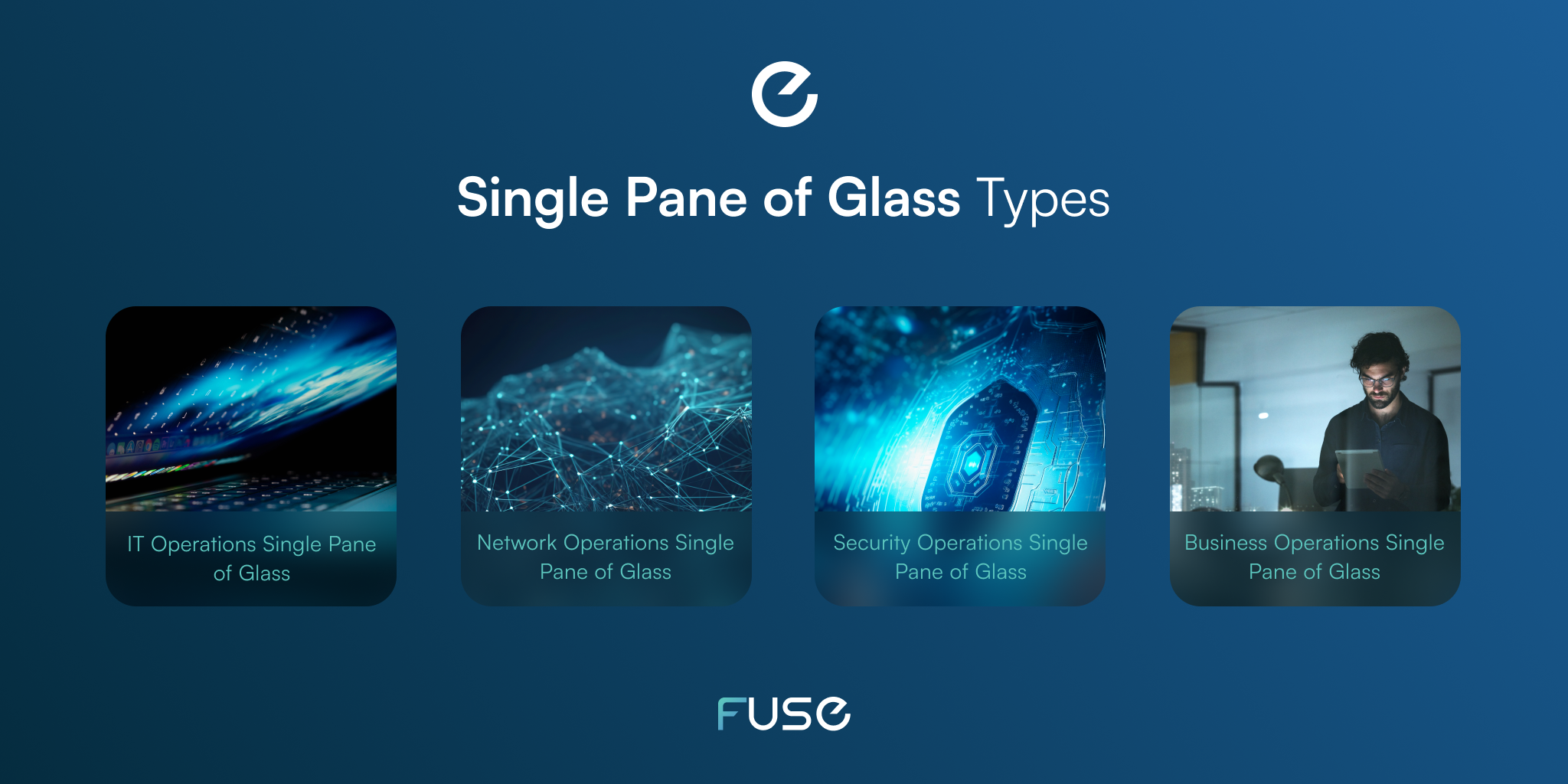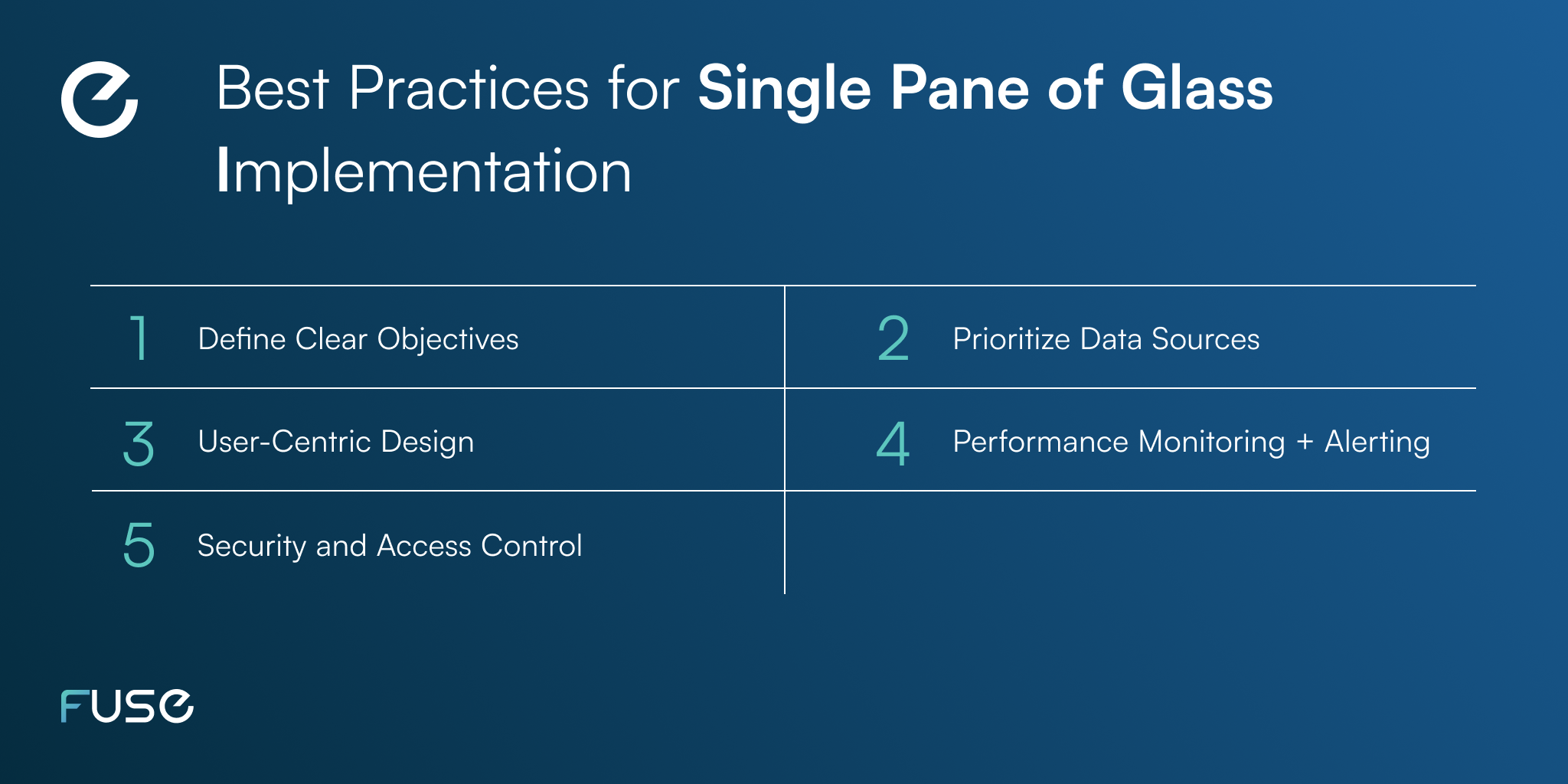Single Pane of Glass – Meaning, Advantages, Challenges


In today’s complex and interconnected digital landscape, managing diverse IT systems, applications, and infrastructure often proves too challenging and time-consuming.
This is why the Single Pane of Glass (SPoG) concept is gaining more and more popularity and is increasingly adopted by organizations. It helps them streamline their processes and enhance efficiency.
Simply put, the Single Pane of Glass refers to a unified interface or dashboard that provides a comprehensive view of various systems, applications, and data sources.
In this blog, we will delve into the Single Pane of Glass concept, explore its advantages and challenges, and discuss best practices for its implementation.
Single Pane of Glass – What is it?
The Single Pane of Glass is a centralized interface that consolidates information from disparate systems into a single, unified dashboard. It acts as a window into the organization’s IT ecosystem, allowing users to monitor, manage, and analyze data from multiple sources in real time.
By integrating various systems, applications, and data streams, the Single Pane of Glass simplifies decision-making, enhances operational efficiency, and improves overall productivity.
The Single Pane of Glass eliminates the traditional reliance of organizations on multiple tools, platforms, and interfaces to monitor and manage their IT infrastructure. With the SPoG, users no longer hop between dedicated interfaces for each system or application, a more complex approach that hinders operational efficiency and decision-making.
A Single Pane of Glass aggregates and presents relevant from different sources in a centralized dashboard. It offers a unified view of critical data, metrics, and insights for users and employees to make informed, more efficient decisions.
A Single Pane of Glass is generally designed with a user-centric approach, focusing on intuitive navigation, visualizations, and filters to enhance usability. Users can drill down into specific areas of interest, access detailed reports, initiate actions, and interact with the underlying systems directly from the dashboard. This unified interface is meant to promote collaboration among teams, facilitate data-driven decision-making, and improve overall operational efficiency.
Single Pane of Glass Types

An organization can implement various types of Single Pane of Glass views, based on its specific needs and requirements. Among the common variations we encounter:
1. IT Operations Single Pane of Glass:
This type of SPoG focuses on consolidating information related to IT infrastructure, systems, and applications. It provides a centralized view of key performance indicators (KPIs), system health, alerts, and other relevant metrics. IT operations teams can monitor and manage the performance, availability, and capacity of different components within the IT ecosystem, enabling them to proactively identify and resolve issues.
2. Network Operations Single Pane of Glass:
A network operations SPoG centralizes information about network devices, traffic, bandwidth utilization, and network performance. It provides visibility into network health, connectivity status, and potential bottlenecks. Network administrators can monitor network infrastructure, troubleshoot connectivity issues, and optimize network performance from a single dashboard.
3. Security Operations Single Pane of Glass:
This type of SPoG consolidates information related to security events, threats, and vulnerabilities across the organization. It integrates data from security systems such as intrusion detection systems (IDS), firewalls, antivirus software, and security logs. Security operations teams can monitor and analyze security incidents, generate reports, and respond to potential threats effectively.
4. Business Operations Single Pane of Glass:
Such a SPoG focuses on aggregating information related to business processes, key performance indicators (KPIs), and business metrics. It provides a comprehensive view of business operations, sales, marketing, finance, and customer engagement. Business stakeholders can track performance, identify trends, and make data-driven decisions to optimize business outcomes.
Naturally, the specific type of SPoG implemented will depend on the organization’s priorities, goals, and the nature of its IT landscape.
Single Pane of Glass Benefits
As per Digi.com, the main feature making the Single Pane of Glass attractive to organizations is the ability to streamline operational data access and monitor everything from one place.
But the advantages range way beyond that. Let’s tackle them one by one:
Unified Visibility – The Single Pane of Glass offers a holistic view of the organization’s IT environment, providing real-time insights into different systems and applications. It eliminates the need to switch between multiple tools and interfaces, enabling faster and more informed decision-making.
Enhanced Efficiency – A unified interface helps IT professionals perform tasks more efficiently. They can monitor and troubleshoot issues across systems from a single dashboard, reducing the time and effort required to identify and resolve problems. This streamlined approach improves operational efficiency and minimizes downtime.
Improved Collaboration – The Single Pane of Glass promotes collaboration by breaking down silos between different teams and departments. It allows stakeholders to share information, collaborate on projects, and align their efforts more effectively.
Real-time Monitoring and Alerting – The Single Pane of Glass enables proactive monitoring of systems and applications, providing real-time alerts for any anomalies or performance degradation. IT teams can set up customized thresholds and receive notifications when issues arise, allowing them to address problems before they impact end users or critical operations.
Simplified Data Analysis – By consolidating data from multiple sources, the Single Pane of Glass facilitates comprehensive data analysis. IT teams can gain actionable insights, identify trends, and make data-driven decisions more effectively.
Single Pane of Glass Challenges
While the Single Pane of Glass offers numerous advantages, its implementation can pose challenges that organizations need to address. We listed some of them:
- Data Integration: Consolidating data from diverse sources can be complex. Organizations must establish robust integration mechanisms, including APIs and connectors, to extract and aggregate data from various systems. Data compatibility and quality assurance are critical to ensure accurate and meaningful insights.
- System Complexity: Organizations often have a mix of legacy systems, on-premises infrastructure, cloud services, and third-party applications. As Several9s pointed out, integrating and standardizing these systems within the Single Pane of Glass can be challenging due to differences in data formats, protocols, and security requirements.
- Scalability: As organizations grow and adopt new technologies, the Single Pane of Glass should scale to accommodate additional systems and data sources. Planning for scalability and flexibility during the design and implementation phases is crucial to ensure long-term success.
Best Practices for Single Pane of Glass Implementation

To ensure organizations maximize the benefits of the Single Pane of Glass, they should follow certain guidelines:
Define Clear Objectives: Clearly define the goals and objectives for implementing the Single Pane of Glass. Identify key metrics, performance indicators, and use cases to ensure alignment with business needs.
Prioritize Data Sources: Identify the critical data sources that need to be integrated into the Single Pane of Glass. Focus on systems and applications that have a significant impact on operations, performance, or customer experience. Start with a phased approach, gradually adding more data sources based on priorities and resource availability.
User-Centric Design: Design the Single Pane of Glass with the end-users in mind. Consider the roles and responsibilities of different users who will interact with the dashboard. Customize the interface to provide relevant information and actionable insights based on specific user requirements. Incorporate intuitive navigation, visualizations, and filters to enhance user experience and ease of use.
Performance Monitoring and Alerting: Implement robust monitoring capabilities within the Single Pane of Glass to track system performance, application responsiveness, and network metrics. Configure alerts and notifications for critical events and threshold breaches. Define escalation procedures and response protocols to address any possible issue.
Security and Access Control: Implement robust security measures to protect the Single Pane of Glass and the underlying systems. Employ strong authentication mechanisms, access controls, and encryption protocols to safeguard sensitive data. Define role-based access control (RBAC) to ensure that users only have access to the information and functionalities relevant to their roles.
To sum up, the Single Pane of Glass is a powerful solution for companies to simplify operations and gain comprehensive visibility into their IT environment. By integrating disparate systems, applications, and data sources, organizations can streamline decision-making, enhance efficiency, and improve collaboration.
eTag Fuse – Your Ideal Single Pane of Glass Solution
At eTag Technologies, we highly value the benefits the Single Pane of Glass can bring and developed an ideal solution for organizations looking to implement the concept.
With the User Experience (UX) Hub of our digital integration platform, eTag Fuse, users benefit from a unified Single Pane of Glass dashboard for streamlined navigation and a productivity boost throughout the day.
Fuse streamlines your digital ecosystem, so your company stays agile for the long term. With a user-friendly dashboard and many other useful features, a successful digital transformation is within reach. Request a demo of Fuse to experience complete application integration.
Sources:


















